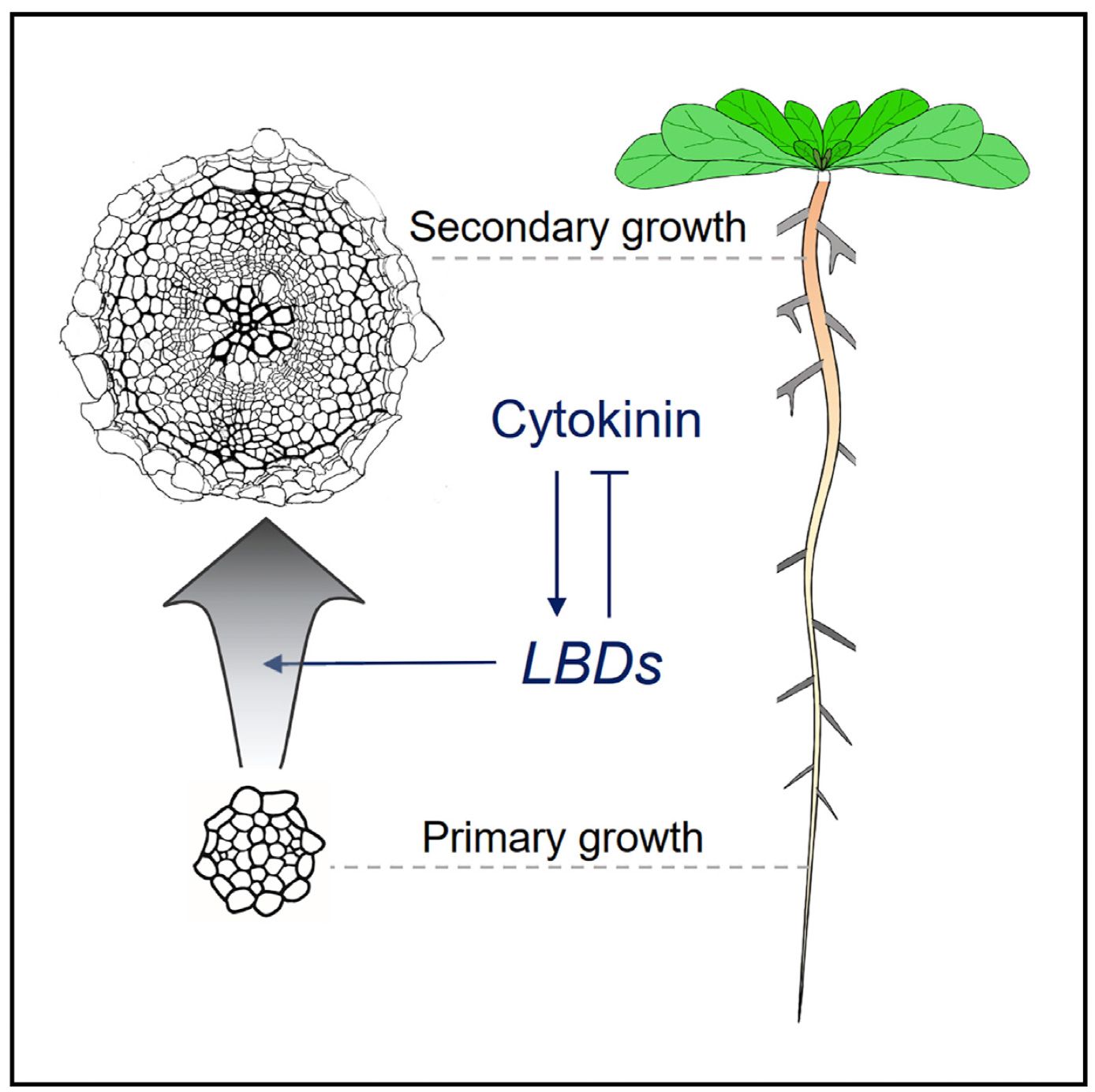博文
Current Biology:拟南芥根组织中,细胞分裂素通过LBDs起始次生生长
||
Cytokinins initiate secondary growth in the Arabidopsis root through a set of LBD genes
第一作者:Lingling Ye
第一单位:赫尔辛基大学
通讯作者:Ari Pekka Mähönen
Abstract
大背景:During primary growth, plant tissues increase their length, and as these tissues mature, they initiate secondary growth to increase thickness. 大问题:It is not known what activates this transition to secondary growth. 小背景:Cytokinins are key plant hormones regulating vascular development during both primary and secondary growth. During primary growth of Arabidopsis roots, cytokinins promote procambial cell proliferation and vascular patterning together with the hormone auxin. In the absence of cytokinins, secondary growth fails to initiate. Enhanced cytokinin levels, in turn, promote secondary growth. 提出问题:Despite the importance of cytokinins, little is known about the downstream signaling events in this process. 主要发现:Here, we show that cytokinins and a few downstream LATERAL ORGAN BOUNDARIES DOMAIN (LBD) family of transcription factors are rate-limiting components in activating and further promoting secondary growth in Arabidopsis roots. 结果1:Cytokinins directly activate transcription of two homologous LBD genes, LBD3 and LBD4. Two other homologous LBDs, LBD1 and LBD11, are induced only after prolonged cytokinin treatment. 结果2:Our genetic studies revealed a two-stage mechanism downstream of cytokinin signaling: while LBD3 and LBD4 regulate activation of secondary growth, LBD1, LBD3, LBD4, and LBD11 together promote further radial growth and maintenance of cambial stem cells. 结果3:LBD overexpression promoted rapid cell growth followed by accelerated cell divisions, thus leading to enhanced secondary growth. 结果4:Finally, we show that LBDs rapidly inhibit cytokinin signaling. 结论:Together, our data suggest that the cambium-promoting LBDs negatively feed back into cytokinin signaling to keep root secondary growth in balance. 摘 要 
在初生生长时,植物组织主要是增加其长度,而当这些组织成熟时,植物会启动次生生长来增加其厚度。但是,目前并不清楚是什么激活了植物向次生生长的转变。细胞分裂素是比较重要的植物激素,在植物初生生长和次生生长过程中,调控维管的发育。在拟南芥根的初生生长中,细胞分裂素会与生长素一起,促进原形成层细胞的分裂和维管的模式建成。缺少细胞分裂素,植物不能起始次生生长;而细胞分裂素水平增加,促进了次生生长。尽管细胞分裂素具有如此重要的作用,但是关于该过程中下游的信号转导事件并不清楚。本文中,作者发现细胞分裂素和下游的LBD转录因子家族的某些成员是激活并促进拟南芥根次生生长的限制性组分。细胞分裂素直接激活两个LBD基因LBD3和LBD4的转录。而两个LBD基因LBD1和LBD11仅在长时间的细胞分裂素处理之后才会被诱导表达。遗传学实验进一步显示,细胞分裂素信号转导下游分为两个阶段:先是LBD3和LBD4基因调控次生生长的激活,然后是LBD1、LBD3和LBD4和LBD11基因一起促进径向生长和形成层干细胞的维持。LBD过表达会促进快速的细胞生长,细胞分裂加速,从而导致次生生长增强。最终,作者发现LBDs能够快速抑制细胞分裂素的信号转导。综上,本文的研究表明,调控形成层的LBDs参与细胞分裂素信号转导的负反馈调节,以保持根系次生生长的平衡。
通讯作者
** Ari Pekka Mähönen **
个人简介: 2006年,芬兰赫尔辛基大学,博士; 荷兰乌得勒支大学,博士后。 研究方向:以拟南芥的根为模型研究植物维管形成层的发育。
doi: https://doi.org/10.1016/j.cub.2021.05.036
Journal: Current Biology
Published online: June 14, 2021
https://blog.sciencenet.cn/blog-3158122-1292024.html
上一篇:Genome Biology:利用挪威云杉育种项目收集的表型数据进行GWAS分析
下一篇:PNAS:水稻束鞘细胞对高光强的局部ROS响应依赖于NADPH氧化酶(补2021-06-22)
全部作者的其他最新博文
- • Plant Physiology:CsMADS3促进柑果中的叶绿素降解和类胡萝卜素合成(华中农业大学)
- • Molecular Plant:LBD11-ROS反馈调节作用于拟南芥的维管形成层增殖和次生生长(浦项科技大学)
- • Science Advances:根结线虫通过调控植物的CLE3-CLV1模块,促进侵染进程(日本熊本大学)
- • Nature Communications:油菜素内酯参与植物营养生长期转变的分子机制解析(浙江农林大学)
- • Current Biology:光合作用产生的蔗糖驱动侧根“生物钟”(德国弗莱堡大学)
- • PNAS:花同源异型基因在叶中被抑制、花中被激活的分子机制(南卡罗来纳大学)